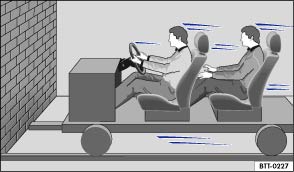Volkswagen Polo Owners Manual: Frontal collisions and the laws of physics

Fig. 45 Unbelted occupants in a vehicle heading for a brick wall

Fig. 46 Unbelted occupants in a vehicle striking a brick wall
 First read and observe the introductory information
and safety warnings
First read and observe the introductory information
and safety warnings
The physical principles involved in a frontal collision are relatively simple. As soon as the vehicle is in motion , both the moving vehicle and its passengers gain kinetic energy.
The higher the vehicle speed and the heavier the weight of the vehicle, the greater the amount of energy that will have to be released in the event of an accident.
However, the most significant factor is the speed of the vehicle. If the speed doubles from approximately 25 km/h (15 mph) to approximately 50 km/h (31 mph), for example, the kinetic energy increases by a factor of four.
The amount of kinetic energy depends on the speed of the vehicle and the weight of the vehicle and passengers. The higher the speed and the heavier the weight, the greater the amount of energy that will be released in the event of an accident.
Passengers not wearing seat belts are not connected to the vehicle. In the event of a frontal collision they will continue to move forwards at the same speed at which the vehicle was travelling before impact, until something stops them. Because the passengers in our example are not restrained by seat belts, the entire amount of kinetic energy will only be released at the point of impact against the wall .
Even at speeds of approximately 30 km/h (19 mph) to approximately 50 km/h (31 mph), the forces acting on bodies in a collision can easily exceed one tonne (1,000 kg). These forces are even greater at higher speeds.
This example applies not only to frontal collisions, but to all accidents and collisions.
 Warning lamp
Warning lamp
Fig. 44 Warning lamp in the instrument
cluster
First read and observe the introductory information
and safety warnings
Lights up or flashes
Possible cause
Solution ...
 What happens to vehicle occupants who have not fastened their seat belts
What happens to vehicle occupants who have not fastened their seat belts
Fig. 47 An unbelted driver is thrown forwards
Fig. 48 The unbelted rear passenger is
thrown forwards, hitting the belted driver
First read and observe the introductory information
and safety ...
Other materials:
Two-Part HS Vario Clear Coat
Definition:
Two-Part HS Vario Clear Coat -L2K 769 K01 A5-
Edition 06/2013
Product Description
Two-part HS vario clear coat is a VOC compliant (VOC value
less than 420 g/L), h ...
Removing and installing the headlights
Fig. 176 In the engine
compartment: securing bolts for the right headlight
Fig. 177 Guides for installing the
right headlight
First read and observe the introductory
information and safety warnings
Depending on the vehicle variant, the headlight may have to be removed in
order to replac ...
Plastic Cleaner
Definition:
Plastic Cleaner -D 195 850 A1-
Edition 04/2009
Product Description
Plastic Cleaner -D 195 850 A1- is a liquid universal cleaner
and thinner with an non-aromatic, ...
